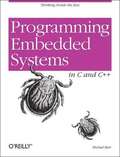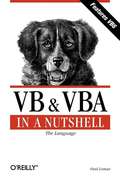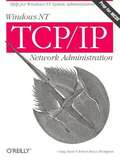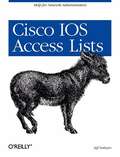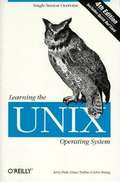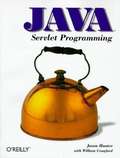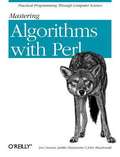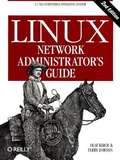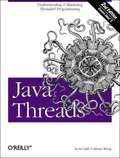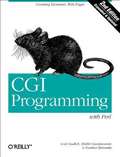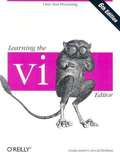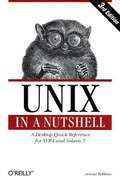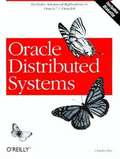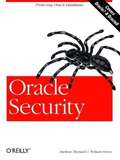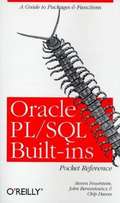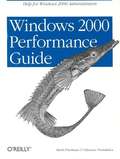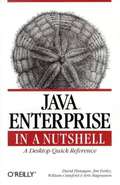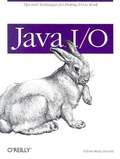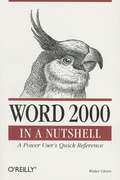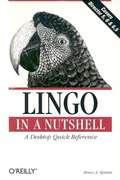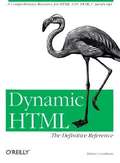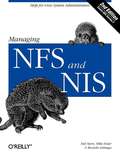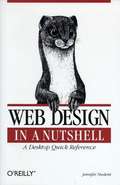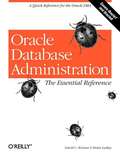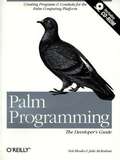- Table View
- List View
Programming Embedded Systems in C and C++
by Michael BarrThis book introduces embedded systems to C and C++ programmers. Topics include testing memory devices, writing and erasing Flash memory, verifying nonvolatile memory contents, controlling on-chip peripherals, device driver design and implementation, optimizing embedded code for size and speed, and making the most of C++ without a performance penalty.
VB & VBA in a Nutshell: The Language
by Paul LomaxFor Visual Basic and VBA programmers, this book boils down the essentials of the VB and VBA languages into a single volume, including undocumented and little-documented areas essential to everyday programming. The convenient alphabetical reference to all functions, procedures, statements, and keywords allows programmers to use this book both as a standard reference guide and as a tool for troubleshooting and identifying programming problems.
Windows NT TCP/IP Network Administration
by Craig Hunt Robert Bruce ThompsonWindows NT TCP/IP Network Administration is a complete guide to setting up and running a TCP/IP network on Windows NT. It starts with the fundamentals-- the protocols, routing, and setup. Beyond that, it covers all the important networking services provided as part of Windows NT, including IIS, RRAS, DNS, WINS, and DHCP. This book is the NT administrator's indispensable guide.
Cisco IOS Access Lists
by Jeff SedayaoThis book focuses on a critical aspect of the Cisco IOS--access lists, which are central to securing routers and networks. Administrators cannot implement access control or traffic routing policies without them. The book covers intranets, firewalls, and the Internet. Unlike other Cisco router titles, it focuses on practical instructions for setting router access policies rather than the details of interfaces and routing protocol settings.
Learning the UNIX Operating System, 4th Edition
by Jerry Peek John Strang Grace Todino-GonguetIf you are new to UNIX, this concise introduction will tell you just what you need to get started and no more. Why wade through a 600-page book when you can begin working productively in a matter of minutes? It's an ideal primer for Mac and PC users of the Internet who need to know a little bit about UNIX on the systems they visit. This book is the most effective introduction to UNIX in print. The fourth edition covers the highlights of the Linux operating system. It's a handy book for someone just starting with UNIX or Linux, as well as someone who encounters a UNIX system on the Internet. And it now includes a quick-reference card. Topics covered include: Linux operating system highlights Logging in and logging out Window systems (especially X/Motif) Managing UNIX files and directories Sending and receiving mail Redirecting input/output Pipes and filters Background processing Basic network commandsv
Java Servlet Programming
by Jason HunterA few years ago, the hype surrounding applets put Java on the map as a programming language for the Web. Today, Java servlets stand poised to take Java to the next level as a Web development language. The main reason is that servlets offer a fast, powerful, portable replacement for CGI scripts. The Java Servlet API, introduced as the first standard extension to Java, provides a generic mechanism to extend the functionality of any kind of server. Servlets are most commonly used, however, to extend Web servers, performing tasks traditionally handled by CGI programs. Web servers that can support servlets include: Apache, Netscape's FastTrack and Enterprise Servers, Microsoft's IIS, O'Reilly's WebSite, and JavaSoft's Java Web Server. The beauty of servlets is that they execute within the Web server's process space and they persist between invocations. This gives servlets tremendous performance benefits over CGI programs. Yet because they're written in Java, servlets are far less likely to crash a Web server than a C-based NSAPI or ISAPI extension. Servlets have full access to the various Java APIs and to third-party component classes, making them ideal for use in communicating with applets, databases, and RMI servers. Plus, servlets are portable between operating systems and between servers -- with servlets you can "write once, serve everywhere." Java Servlet Programming covers everything you need to know to write effective servlets and includes numerous examples that you can use as the basis for your own servlets. The book explains the servlet life cycle, showing how you can use servlets to maintain state information effortlessly. It also describes how to serve dynamic Web content, including both HTML pages and multimedia data. Finally, it explores more advanced topics like integrated session tracking, efficient database connectivity using JDBC, applet-servlet communication, inter-servlet communication, and internationalization.
Mastering Algorithms with Perl
by Jon Orwant Jarkko Hietaniemi John MacdonaldMany programmers would love to use Perl for projects that involve heavy lifting, but miss the many traditional algorithms that textbooks teach for other languages. Computer scientists have identified many techniques that a wide range of programs need, such as: Fuzzy pattern matching for text (identify misspellings!) Finding correlations in data Game-playing algorithms Predicting phenomena such as Web traffic Polynomial and spline fitting Using algorithms explained in this book, you too can carry out traditional programming tasks in a high-powered, efficient, easy-to-maintain manner with Perl. This book assumes a basic understanding of Perl syntax and functions, but not necessarily any background in computer science. The authors explain in a readable fashion the reasons for using various classic programming techniques, the kind of applications that use them, and -- most important -- how to code these algorithms in Perl. If you are an amateur programmer, this book will fill you in on the essential algorithms you need to solve problems like an expert. If you have already learned algorithms in other languages, you will be surprised at how much different (and often easier) it is to implement them in Perl. And yes, the book even has the obligatory fractal display program. There have been dozens of books on programming algorithms, some of them excellent, but never before has there been one that uses Perl. The authors include the editor of The Perl Journal and master librarian of CPAN; all are contributors to CPAN and have archived much of the code in this book there. "This book was so exciting I lost sleep reading it." Tom Christiansen
Linux Network Administrator's Guide, Second Edition
by Terry Dawson Olaf KirchFully updated, this impressive, comprehensive introduction to networking on Linux now covers firewalls, including the use of ipchains and iptables (netfilter), masquerading, and accounting. Other new topics include Novell (NCP/IPX) support and INN (news administration). Original material on serial connections, UUCP, routing and DNS, mail and News, SLIP and PPP, NFS, and NIS has been thoroughly updated.
Java Threads, 2nd Edition
by Scott Oaks Henry WongThreads aren't a new idea: many operating systems and languages support them. But despite widespread support, threads tend to be something that everyone talks about, but few use. Programming with threads has a reputation for being tricky and nonportable. Not so with Java. Java's thread facilities are easy to use, and--like everything else in Java--are completely portable between platforms. And that's a good thing, because it's impossible to write anything but the simplest applet without encountering threads. If you want to work with Java, you have to learn about threads. This new edition shows you how to take full advantage of Java's thread facilities: where to use threads to increase efficiency, how to use them effectively, and how to avoid common mistakes. Java Threads discusses problems like deadlock, race condition, and starvation in detail, helping you to write code without hidden bugs. It brings you up to date with the latest changes in the thread interface for JDK 1.2. The book offers a thorough discussion of the Thread and ThreadGroup classes, the Runnable interface, the language's synchronized operator. It explains thread scheduling ends by developing a CPUSchedule class, showing you how to implement your own scheduling policy. In addition, Java Threads shows you how to extend Java's thread primitives. Other extended examples include classes that implement reader/writer locks, general locks, locks at arbitrary scope, and asynchronous I/O. This edition also adds extensive examples on thread pools, advanced synchronization technique, like condition variables, barriers, and daemon locks. It shows how to work with classes that are not thread safe, and pays special attention to threading issues with Swing. A new chapter shows you how to write parallel code for multiprocessor machines. In short, Java Threads covers everything you need to know about threads, from the simplest animation applet to the most complex applications. If you plan to do any serious work in Java, you will find this book invaluable. Examples available online. Covers Java 2.
CGI Programming with Perl, 2nd Edition
by Gunther Birznieks Scott Guelich Shishir GundavaramProgramming on the Web today can involve any of several technologies, but the Common Gateway Interface (CGI) has held its ground as the most mature method--and one of the most powerful ones--of providing dynamic web content. CGI is a generic interface for calling external programs to crunch numbers, query databases, generate customized graphics, or perform any other server-side task. There was a time when CGI was the only game in town for server-side programming; today, although we have ASP, PHP, Java servlets, and ColdFusion (among others), CGI continues to be the most ubiquitous server-side technology on the Web. CGI programs can be written in any programming language, but Perl is by far the most popular language for CGI. Initially developed over a decade ago for text processing, Perl has evolved into a powerful object-oriented language, while retaining its simplicity of use. CGI programmers appreciate Perl's text manipulation features and its CGI.pm module, which gives a well-integrated object-oriented interface to practically all CGI-related tasks. While other languages might be more elegant or more efficient, Perl is still considered the primary language for CGI. CGI Programming with Perl, Second Edition, offers a comprehensive explanation of using CGI to serve dynamic web content. Based on the best-selling CGI Programming on the World Wide Web, this edition has been completely rewritten to demonstrate current techniques available with the CGI.pm module and the latest versions of Perl. The book starts at the beginning, by explaining how CGI works, and then moves swiftly into the subtle details of developing CGI programs. Topics include: Incorporating JavaScript for form validation Controlling browser caching Making CGI scripts secure in Perl Working with databases Creating simple search engines Maintaining state between multiple sessions Generating graphics dynamically Improving performance of your CGI scripts
Learning the vi Editor, Sixth Edition
by Linda Lamb Arnold RobbinsThis completely updated guide to editing with vi, the editor available on nearly every Unix system, now covers four popular viclones and includes command summaries for easy reference. It starts with the basics, followed by more advanced editing tools, such as ex commands, global search and replacement, and a new feature, multiscreen editing.
UNIX in a Nutshell: System V Edition
by Arnold RobbinsThe bestselling, most informative Unix reference book is now more complete and up to date. Not a scaled-down quick reference of common commands, UNIX in a Nutshell is a complete reference containing all commands and options, with descriptions and examples that put the commands in context. For all but the thorniest Unix problems, this one reference should be all you need. Covers System V Release 4 and Solaris 7.
Oracle Distributed Systems
by Charles DyeThis book describes how you can use multiple databases and both Oracle8 and Oracle7 distributed system features to best advantage. It covers design, configuration of SQL*Net/Net8, security, and Oracle's distributed options (advanced replication, snapshots, multi-master replication, updateable snapshots, procedural replication, and conflict resolution). Includes a complete API reference for built-in packages and a diskette with many helpful scripts and utilities.
Oracle Security
by William Heney Marlene TheriaultThis book covers the field of Oracle security from simple to complex. It describes basic RDBMS security features (e.g., passwords, profiles, roles, privileges, synonyms) and includes many practical strategies for securing an Oracle system, developing auditing and backup plans, and using the Oracle Enterprise Manager and Oracle Security Server. Also touches on advanced security features, such as encryption, Trusted Oracle, and Internet and Web protection.
Oracle PL/SQL Built-ins Pocket Reference
by Chip Dawes Steven Feuerstein John BeresniewiczThis companion quick reference to Steven Feuerstein's bestselling Oracle PL/SQL Programming and Oracle Built-in Packages will help you use Oracle's extensive set of built-in functions and packages, including those new to Oracle8. You'll learn how to call numeric, character, date, conversion, large object (LOB), and miscellaneous functions, as well as packages like DBMS_SQL and DBMS_OUTPUT.
Windows 2000 Performance Guide
by Mark Friedman Odysseas PentakalosMost computer systems do not degrade gradually. The painful reality is that performance is acceptable day after day, until quite suddenly it all falls apart. If this happens on a system you're responsible for, you'll need to be prepared to get your organization through the crisis. Windows 2000 Performance Guide will give you the information and the conceptual framework to become your own Windows 2000 performance expert.
Java Enterprise in a Nutshell
by Jim Farley David Flanagan William Crawford Kris MagnussonJava Enterprise in a Nutshell is an indispensable quick reference for Java programmers who are writing distributed enterprise applications. The book provides fast-paced tutorials on the following Java Enterprise APIs: JDBC, a vendor-independent API for accessing relational database systems RMI, a Java-only approach to distributed computing that relies on remote method invocation Java IDL, a CORBA-based, language-independent approach to distributed computing Java servlets, a mechanism for extending a web server that allows Java code to perform tasks traditionally handled by CGI scripts JNDI, a generic Java API for working with networked naming and directory services Enterprise JavaBeans, a component model that separates high-level business logic from low-level housekeeping chores like security and transaction management These APIs are the building blocks of the Java 2 Platform, Enterprise Edition (J2EE), Sun's recently announced new platform for enterprise computing. J2EE is the standard Java 2 platform with a number of extensions for enterprise development. Java Enterprise in a Nutshell also contains O'Reilly's classic-style, quick-reference material for all of the classes in the various packages that comprise the Enterprise APIs. This material includes the core Enterprise APIs that are part of Java 1.2, as well as numerous standard extensions. This book is a companion to both Java in a Nutshell, 3rd Edition, which covers the key non-graphical, non-enterprise APIs in Java 1.2, and Java Foundation Classes in a Nutshell, which describes the graphics- and GUI-related classes of Java 1.2.
Java I/O
by Elliotte Rusty HaroldAll of Java's Input/Output (I/O) facilities are based on streams, which provide simple ways to read and write data of different types. Java I/O tells you all you need to know about the four main categories of streams and uncovers less-known features to help make your I/O operations more efficient. You'll also learn how to control number formatting, use characters aside from the standard ASCII character set, and get a head start on writing truly multilingual software.
Word 2000 in a Nutshell
by Walter GlennWord 2000 in a Nutshellis a clear, concise, and complete reference to the most popular word-processing program in the world. This book is the first choice of the Word power user who needs help completing a specific task or understanding a command or topic. It's also an invaluable resource that uncovers Word 2000's undocumented features and shares powerful time-saving tips.
Lingo in a Nutshell
by Bruce A. EpsteinMacromedia Director 6 is the premiere authoring tool for delivering interactive content on both the Internet and the desktop. It is the dominant multimedia package for Windows 95/NT, Windows 3.1, and the Macintosh. A quarter million developers use Director(R) to incorporate animation and audio into dynamic Web pages, and to create engaging interactive corporate presentations, multimedia advertising, entertainment CD-ROMs, Enhanced music CDs, and even DVDs. Lingo is Director's powerful scripting language. This companion book to Director in a Nutshell is an essential tool for both new and experienced Lingo programmers seeking a deeper knowledge of the language. Bruce Epstein is the author of both these books and brings years of hands-on experience with Director and Lingo. The book includes numerous useful Lingo examples. Exhaustively tested, this book corrects many errors found in Macromedia's Lingo documentation and repeated verbatim in most third-party books. Extremely comprehensive, this book details dozens of misdocumented and undocumented Lingo keywords that are omitted from Macromedia's manuals and third-party books. Lingo in a Nutshell caters to the huge pool of Director users attempting to bridge the Lingo gap, yet provides the details for the experienced Linguist that are lacking in other Lingo books. In typical nutshell style (clear, concise, deep and narrow) this book explores the syntax, structure and commands of the Lingo language. The detailed chapters describe messages, events, scripts, handlers, variables, lists, file I/O, Behaviors, child objects, Xtras, and more. This book teaches you to troubleshoot and debug common Lingo errors. Lingo in a Nutshell is the book for which both Director users and power Lingo programmers have been yearning. The book extensively covers topics not found in other Lingo books: Cross-platform Lingo differences Lingo internals for experienced programmers Events, messages, and scripts Timers, tempos, cue points, and synchronization Data types and expressions Math, numerical expressions, geometry, and trigonometry Coordinates, alignment, and registration point Lingo in a Nutshell is the most concise and compete guide available. It is a high-end handbook at a low-end price. An essential desktop reference for every Director user.
Dynamic HTML: The Definitive Reference
by Danny GoodmanIf you are a Web content developer these days, you have a lot of information to keep track of. You need to stay current on the relevant Web specifications, like HTML, CSS, DOM, and ECMAScript. You also need to know how the latest Web browsers from Netscape and Microsoft actually implement these standards, since browser implementations of the standards are less than perfect. Right now, you're forced to keep multiple reference books open on your desk (or multiple browser windows open on your screen), just to develop a simple dynamic Web page that works properly under both Navigator and Internet Explorer. Dynamic HTML: The Definitive Reference changes all that. This book is an indispensable compendium for Web content developers. It contains everything you need to create functional cross-platform Web applications, including: A complete reference for all of the HTML tags, CSS style attributes, browser document objects, and JavaScript objects supported by the various standards and the latest versions of Navigator and Internet Explorer. Browser compatibility is emphasized throughout; the reference pages clearly indicate browser support for every entity. Handy cross-reference indexes that make it easy to find interrelated HTML tags, style attributes, and document objects. An advanced introduction to creating dynamic Web content that addresses the cross-platform compromises inherent in Web page design today. If you have some experience with basic Web page creation, but are new to the world of dynamic content, Dynamic HTML: The Definitive Reference will jump-start your development efforts. If you are an experienced Web programmer, you'll find the browser-compatibility information invaluable. This book is the only DHTML reference that a Web developer needs. Dynamic HTML: The Definitive Reference is designed to work in conjunction with HTML: The Definitive Guide and JavaScript: The Definitive Guide . HTML: The Definitive Guide teaches you about every element of HTML in detail, with explanations of how each element works and how it interacts with other elements, as well as numerous examples. JavaScript: The Definitive Guide provides a thorough description of the JavaScript language, complete with sophisticated examples that show you how to handle common Web application tasks. Together, these three books provide a complete library for Web content developers.
Managing NFS and NIS, 2nd Edition
by Mike Eisler Ricardo Labiaga Hal SternThis long-awaited new edition of a classic, now updated for NFS Version 3 and based on Solaris 8, shows how to set up and manage a network filesystem installation. Managing NFS and NIS is the only practical book devoted entirely to NFS and the distributed database NIS; it's a "must-have" for anyone interested in Unix networking.
Web Design in a Nutshell
by Jennifer Niederst RobbinsWeb Design in a Nutshell contains the nitty-gritty on everything you need to know to design Web pages. It's the good stuff, without the fluff, written and organized so that answers can be found quickly. Written by veteran Web designer Jennifer Niederst, this book provides quick access to the wide range of front-end technologies and techniques from which Web designers and authors must draw. It is an excellent reference for HTML 4.0 tags (including tables, frames, and Cascading Style Sheets) with special attention given to browser support and platform idiosyncrasies. The HTML section is more than a reference work, though. It details strange behavior in tables, for instance, and gives ideas and workarounds for using tables and frames on your site. Web Design in a Nutshell also covers multimedia and interactivity, audio and video, and emerging technologies like Dynamic HTML, XML, embedded fonts, and internationalization. The book includes: Discussions of the Web environment, monitors, and browsers A complete reference to HTML and Server Side Includes, including browser support for every tag and attribute Chapters on creating GIF, JPEG and PNG graphics, including designing with the Web Palette Information on multimedia and interactivity, including audio, video, Flash, Shockwave, and JavaScript Detailed tutorial and reference on Cascading Style Sheets, including an appendix of browser compatibility information Appendices detailing HTML tags, attributes, deprecated tags, proprietary tags, and CSS compatibility
Oracle Database Administration, The Essential Reference
by David C. Kreines Brian LaskeyA concise reference to the enormous store of information Oracle8 or Oracle7 DBAs need every day, Oracle Database Administrationcovers DBA tasks like installation, tuning, backups, networking, auditing, and query optimization. It's also a set of quick references on initialization parameters, SQL statements, data dictionary tables, system privileges, roles, and syntax for SQL*Plus, Export, Import, and SQL*Loader.
Palm Programming: The Developer's Guide
by Julie Mckeehan Neil RhodesPalmPilot's popularity is growing and with over a million units sold, the Palm OS dominates the hand-held market. Wired has astutely described Palm's position in a recent article: "On its way to becoming the bestselling hand-held computer of all time, the 3Com PalmPilot has spawned an intense, emotional, and fanatical developer following not seen since the glory days of the Mac." (Wired, 20 Feb. 98). Palm Programming should be eagerly accepted by programmers because the authors worked closely with Palm to ensure that the book is tailored exactly to the needs of the ever-growing group of Palm developers. As nothing but some piecemeal documentation exists currently, this book provides a much needed solution to the Palm developers. In fact, Palm uses this book as their official developer's guide and will be using it in the future as a key part of their training materials for developers. There are currently no books on Palm programming (and we know of none that are planned). The only way to learn is by using the reference material published by Palm (available freely on their Web site), the tutorial they provide, or various Palm programming FAQs compiled by third parties. Palm Programming shows intermediate to experienced C programmers how to build a Palm application from the ground up. Using an easy-to- understand tutorial approach, this book gives readers everything necessary to create a wide range of Palm applications and conduits, from simple scripts through full-blown applications, and in the process provides thorough coverage of Palm programming. It includes a CD-ROM (Macintosh and Windows compatible) with the full source code to the examples in the book, a trial version of Palm's Software Development Kit, and third-party developer tools, including Metrowerks' CodeWarrior Lite programming kit. Outline Part 1: Overview of Palm OS and devices Chapter 1: The Palm Solution Chapter 2: Developing for Palm OS Chapter 3: Designing a solution Part 2: Programming for the handheld Chapter 4: Structure of an Application Chapter 5: Forms and Form Objects Chapter 6: Databases Chapter 7: Menus Chapter 8: Extras Chapter 9: Communications Chapter 10: Debugging Part 3: Programming for the desktop: conduits Chapter 11: Getting started with conduits Chapter 12: Uploading and Downloading Data Chapter 13: Two-way Syncing Appendix: Where to go from here
